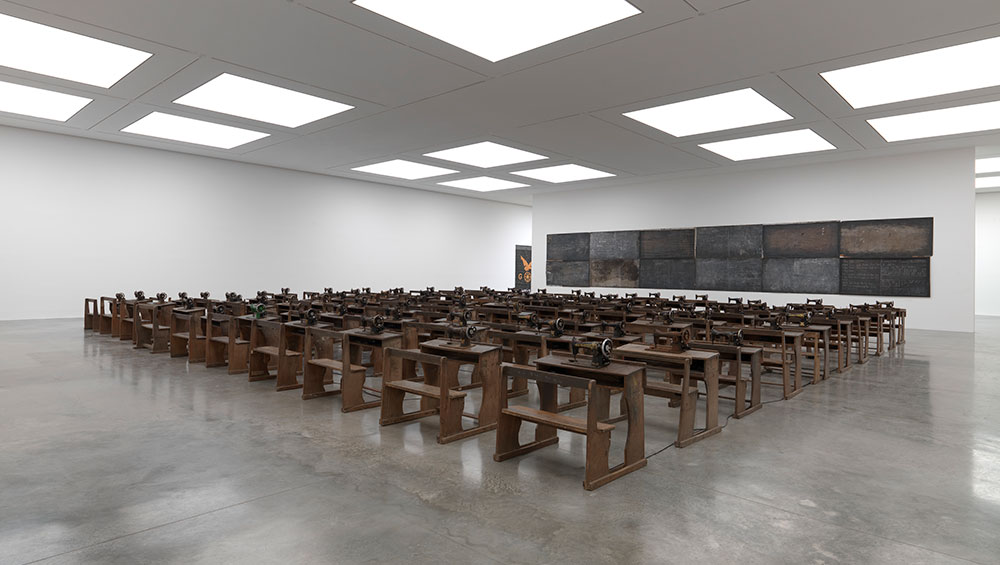
Ibrahim Mahama: Lazarus. White Cube Bermondsey, 15 September – 7 November 2021. © the artist. Photo © White Cube (Todd-White Art Photography).
White Cube Bermondsey, London
15 September – 7 November 2021
by VERONICA SIMPSON
Ibrahim Mahama (b1987, Ghana) uses found remnants of the rotting infrastructure of Ghana’s failed 20th-century projects – whether those of its British colonial rulers or the independent government that emerged in 1957. You could say he is a master of creative reuse: architecture, furniture, fading and dog-eared files and order books, maps, jute sacks, tarpaulin, antique equipment - any or all of it might be deployed to great effect in sculptures, immersive installations or film to highlight the ways in which the state (and not just Ghana’s) fails its citizens. Migration, globalisation and economic exchange are also very much at the core of his investigations.
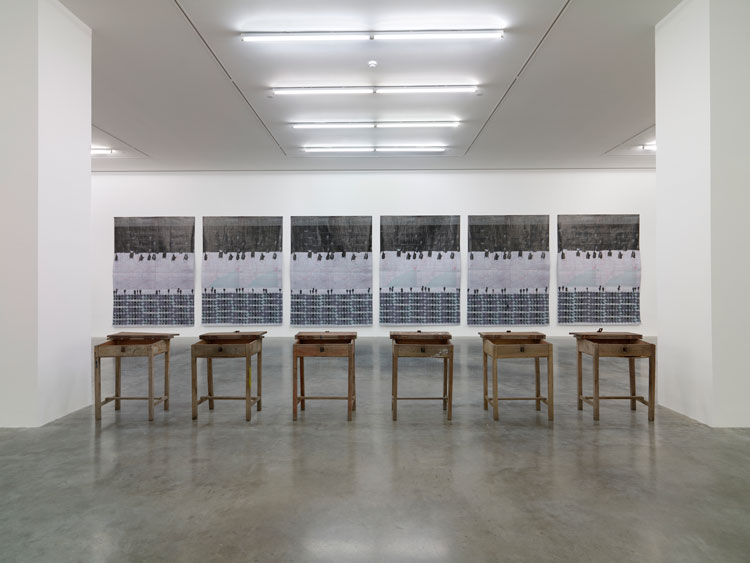
Ibrahim Mahama: Lazarus. White Cube Bermondsey, 15 September – 7 November 2021. © the artist. Photo © White Cube (Todd-White Art Photography).
For this major solo presentation at White Cube Bermondsey, Mahama occupies all its monumental white spaces, haunting them with the spirit of another monumental space, in Ghana – a brutalist concrete silo built just after independence to store grain and other foodstuff for this proud new nation, but abandoned in 1966. Nature took over and soon it was home to a new ecosystem of reptiles, fish, birds and a huge colony of bats. Mahama recently acquired the building and renamed it Nkrumah Voli-ni (after Kwame Nkrumah, the first president of independent Ghana, and voli-ni meaning “inside the hole”). He has now transformed it into a cultural centre - though apparently taking measures to accommodate its bat population.
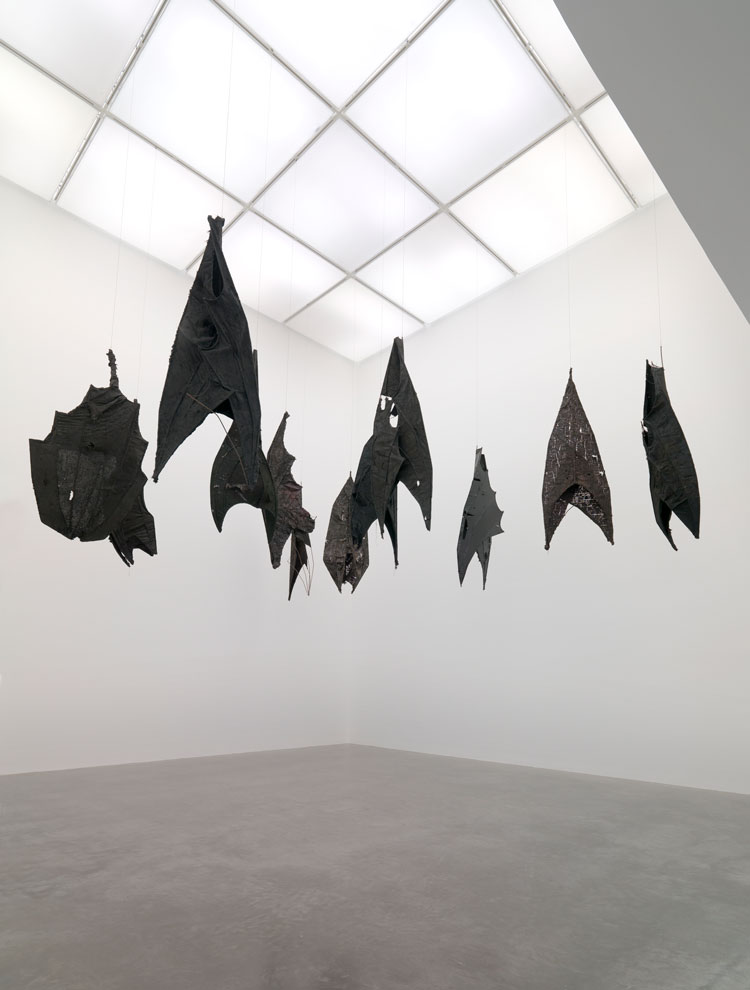
Ibrahim Mahama: Lazarus. White Cube Bermondsey, 15 September – 7 November 2021. © the artist. Photo © White Cube (Todd-White Art Photography).
Bats are the dominant feature of this show, with the titular work, Lazarus (2021) the first to greet the visitor: a cluster of bat-like suspended sculptures made from discarded metal reinforcing bars and tarpaulin sheets drenched in oil, much of which has been salvaged from Mahama’s favourite scrapyard, Agbogbloshie, in Accra, Ghana’s capital city.
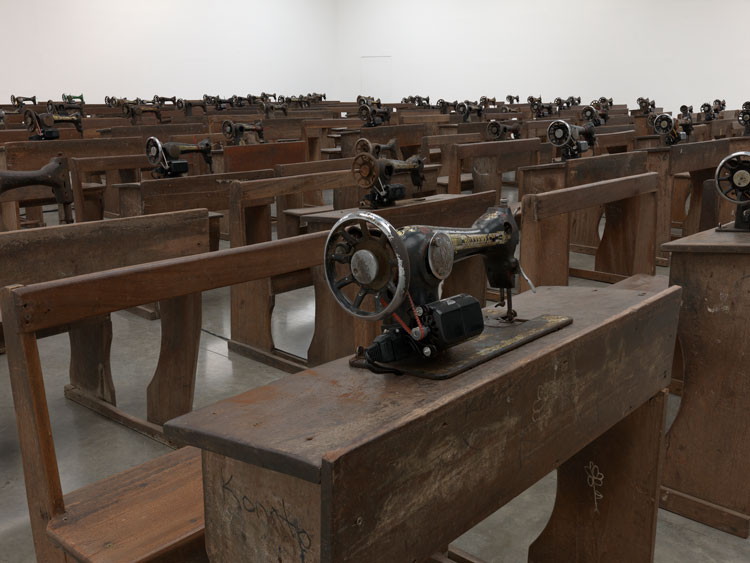
Ibrahim Mahama: Lazarus. White Cube Bermondsey, 15 September – 7 November 2021. © the artist. Photo © White Cube (Todd-White Art Photography).
The gallery is haunted by another phenomenon: a loud, metallic whirring noise erupts from time to time, builds to a crescendo and is followed by an eery silence. The sound seems to emanate from the South Gallery, the first space of which displays three large collages bearing the crest of the now-privatised Ghana Railway Corporation. The noise is emanating from the room behind; could it be a large toy train track? No, it’s a cacophony of sewing machines: for Capital Corpses (2019-21), Mahama has assembled 100 rusted but repurposed sewing machines nailed to the lids of 100 colonial-era school desks, all sweat and ink-stained, and adorned with authentic graffiti.

Ibrahim Mahama: Lazarus (detail). White Cube Bermondsey, 15 September – 7 November 2021. Photo: Veronica Simpson.
These sewing machines are symbolic of Ghana’s post-independent economic ambitions, once-ubiquitous tools offered to workers as an easy entry into trade. Resurrecting these, Mahama has said, is a way to access “the ghosts that are in the machines”. They are lined up, classroom-style, in front of a wall of knackered blackboards, still bearing ancient chalked sums and English grammar exercises.

Ibrahim Mahama: Lazarus (detail). White Cube Bermondsey, 15 September – 7 November 2021. Photo: Veronica Simpson.
This is a powerful indictment of failed educational and economic programmes: the repercussions these failures have had on the nation and its people are drummed home all the more effectively by the intermittently hammering needles. A quieter power is displayed by the huge collages on the other side of those blackboards. That Ghana Railway trilogy - actual title: 4 Degrees 1 (2021) - uses an exact replica of the original company logo; I checked to see whether the eagle on the original logo really bore such a troubled or forlorn expression, and it does. But against a thick, tarry black background, the eagle and lettering take on a more sinister tone, eerily reminiscent of Nazi iconography. Each of these logos is plastered over an aged map of Ghana, just visible below, with the oily backdrop, adorned with a frill of bat shapes.
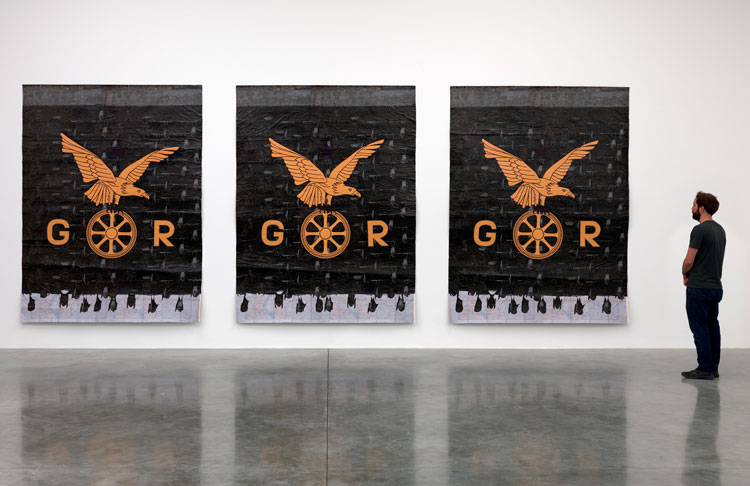
Ibrahim Mahama: Lazarus. White Cube Bermondsey, 15 September – 7 November 2021. © the artist. Photo © White Cube (Todd-White Art Photography).
Bats are everywhere, including across a huge collage on the adjacent wall that features yellowed order-book pages from the paint division of the Ghana Industrial Holding Corporation. On the opposite wall, bats are suspended like dancing notes on a stave, below thick, tarry stripes and more age-stained orders. Adjacent to this is a huge honeycomb collage, the geometric patterns of which turn out to be made of photographs of empty silos. These are, for me, the most effective of the collaged wall pieces. The gallery across the way has many more collages, usually smaller in scale, also featuring bats – though, this time, they are blurry photographic representations of bats as well as the aforementioned empty silos. These images are rather inexpertly snipped out and pasted time and again on to defunct colonial-era maps, bank notebooks, orders and ledgers from the 1960s to the 90s. After a certain point, this repetition (without any meaningful variation) becomes a kind of fetishisation of decay rather than a critique.
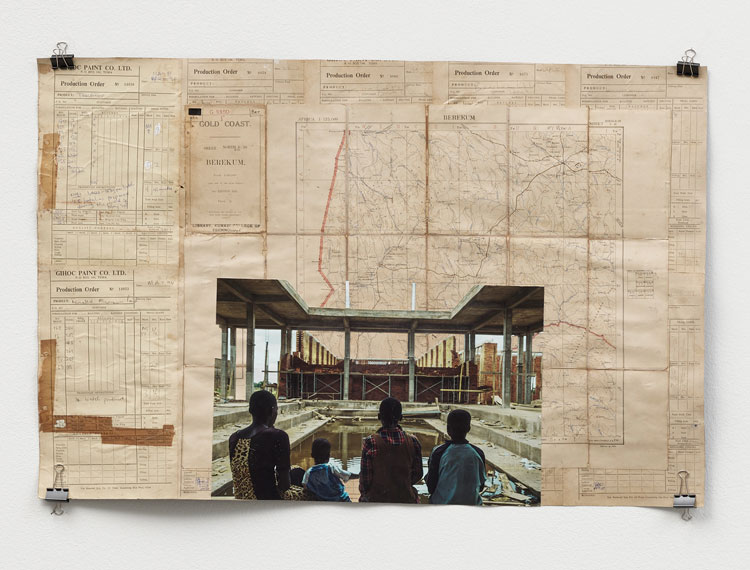
Ibrahim Mahama: Lazarus. White Cube Bermondsey, 15 September – 7 November 2021. © the artist. Photo © White Cube (Todd-White Art Photography).
The film Mahama has made, which runs quietly in the end gallery, is subtle and all the more effective for it. Called Yesterday (2018-21), it is a two-screen presentation of the excavation of the silo on the one side, with some moving overhead shots of people digging into the thick mud, clearing out decades of silt and sludge (oh, the hard, physical labour!) while, on the right screen, we see the less physically gruelling but more patient labour of cleaning, oiling and refurbishing the aforementioned sewing machines. In this film, Mahama is flagging up the importance of collaboration and co-existence.